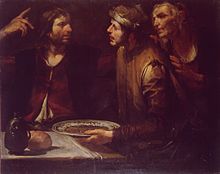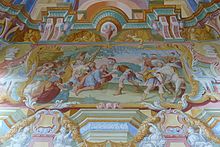Esau
![]()
The title of this article is ambiguous. For other meanings, see Esau (disambiguation).
![]()
Esaw is a redirect to this article. For the Togolese politician of the same name, see Kofi Esaw.
Esau (Hebrew עֵשָׂו, transliterated: 'SW; transliterated: 'Esau, also called Edom Hebrew אדום) is a figure in the Torah of the Tanakh or Old Testament of the Bible, and is considered the progenitor of the Edomites and Amalekites. He is the son of Isaac and Rebekah, his younger twin brother is Jacob, and his later father-in-law is Ishmael, the son of Abraham.

Esau sells his birthright. Gioacchino Assereto, c. 1645

Isaac Rejects Esau. Isaac Master fresco in the Basilica of San Francesco over the tomb of St. Francis of Assisi in Assisi, c. 1290
Esau in the Bible
When Esau has grown up, his brother Jacob deprives him of the birthright in exchange for a dish of lentils (Gen 25 EU). But a serious conflict between the two brothers only arises when Jacob, encouraged and actively supported by his mother Rebekah, also deprives the elder of his father's blessing. Convinced by deception that the eldest son kneels before him, the age-blind father pronounces his solemn blessing over Jacob. For Esau, who later returns home, only one saying remains, with the words, "Behold, thou shalt dwell without fatness of earth, and without dew of heaven from above. By thy sword shalt thou feed, and thy brother shalt thou serve. But it shall come to pass, that thou shalt break his yoke from off thy neck.
A reconciliation scene between Jacob and Esau in later years is described in Genesis ch. 33. According to the genealogy in ch. 36, Esau takes three local wives and moves away to the mountains of Seir. Esau is equated with Edom and becomes the progenitor of the Edomites (Gen 36:1 43 EU). The reason given for the departure is that because of his wealth the land is not large enough for Jacob's camp and Esau's camp.
According to Gen 26:34, Esau takes as wives, at the age of forty, Judith the daughter of Beeri the Hittite and Basemath the daughter of Elon the Hittite. (Gen 26:34 EU) Later he also takes as his wife Mahalath, the sister of Nebajoth, the daughter of Ishmael son of Abraham. (Gen 28:8f EU)

Reconciliation between Jacob and Esau, Rein Abbey, Hall of Homage, fresco by Joseph Amonte, 1740
The story of Esau as an art motif
In art, the blessing of Isaac to Jacob is also depicted. One sees an older man lying in bed, who blesses his son, behind him the mother can be seen.
A pen and brush drawing from around 1648-50 by Rembrandt van Rijn shows Esau exchanging a lentil dish with Jacob for his birthright.
On one of the two end walls of the Hall of Homage in Rein Abbey, Styria, Joseph Amonte depicted Jacob's reconciliation with his brother Esau in a wall fresco in 1740.
Search within the encyclopedia